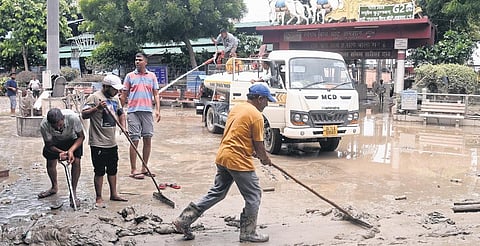Yamuna crosses danger mark again
NEW DELHI: A day after gradual decrease, the water level at the Old Railway Bridge was recorded above the danger mark on Wednesday. In the morning, the water level was 205.6 metres breaching the ‘danger’ mark once again and further rose to 205.7 metres by 6 pm and 205.83 metres by 8 pm.
At 8 pm on Tuesday, the Yamuna water level had dropped below the danger level of 205.33 metres and was recorded at 205.3 metres. Earlier, the water level of the Yamuna had crossed 205.48 metres on Monday morning. This was slightly above the danger mark of 205.33 metres, even as the waterlogging persisted in several parts of the national capital.
At 5 pm on July 10, the Yamuna River in Delhi had crossed the danger mark of 205.33 metres. The river reached 208.66 metres last Thursday, surpassing the previous record of 207.49 metres set in September 1978 by a significant margin. It breached embankments and penetrated deeper into the city than it has in over four decades. The flow rate at the Hathnikund barrage saw a marginal rise on Tuesday afternoon, oscillating between 50,000 and 60,000 cusecs. It dropped to around 39,000 cusecs by 7am on Wednesday. One cusec is equivalent to 28.32 litres per second.
Though the water has receded from prominent areas across the city, low-lying areas are still submerged. Due to floods in the Yamuna, several areas, including Rajghat-Shantivan, ITO, and Ring Road have been affected by waterlogging. To address this, various agencies of the central government, Delhi government and MCD are working together on a war footing. Waterlogging near ITO Flyover has almost been resolved, and the road has been opened for traffic. The work to remove the mud caused by the floods is also progressing rapidly. Agencies are cleaning the roads through pressure pipes to ensure no inconvenience is caused to the commuters.
The Delhi government said that there is a problem of waterlogging in Raj Ghat and other nearby monuments after the floods. The 250-acre premises of Rajghat has been severely impacted, and immediate efforts are being made to drain out the stagnant water on priority. Raj Ghat is a place of national importance and attracts visitors from all over the world. Therefore, all agencies are working together to drain out the water as soon as possible.

